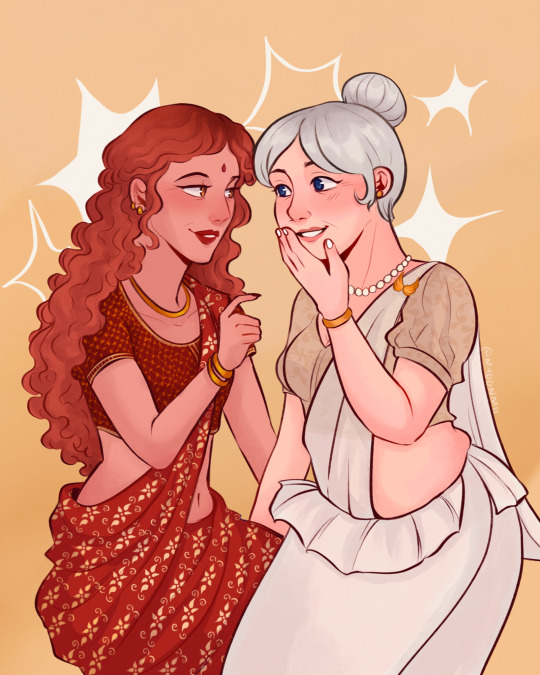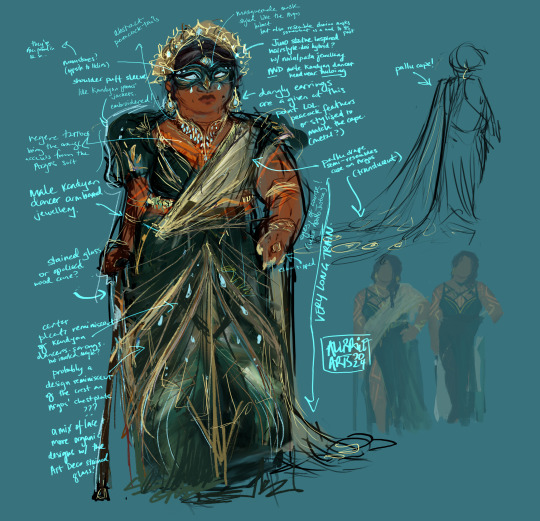#kandyan
Explore tagged Tumblr posts
Text

Group of Kandyan Singhalese from Ceylon, Sri Lanka
British vintage postcard
#briefkaart#photography#vintage#tarjeta#singhalese#postkaart#postal#british#ceylon#photo#lanka#postcard#historic#carte postale#sri lanka#kandyan#kandyan singhalese#ephemera#sepia#ansichtskarte#postkarte#group
2 notes
·
View notes
Text

You’ve heard of ineffable wives in the 60s now get ready for ineffable wives in sarees!
#good omens#ineffable husbands#ineffable wives#good omens fanart#ineffable wives you will always be famous#I just really wanted to draw them in sarees#kandyan saree for aziraphale!#ineffable wives fanart#Genderbent good omens#ineffable husbands fanart#good omens s2#what are they giggling about#aziraphale#crowley#azicrow
355 notes
·
View notes
Text

Kandyan dancer-style Miku concept!
Based on:

#my art#doodle#fan art#original#hatsune miku#miku#vocaloid#character design#alternate outfit#micchi#tayasui sketches#kandy#kandyan dancer#sri lanka#costume design#alternate costume
178 notes
·
View notes
Note
father tony im sorry but whenever you use the word "gingerly" in ur writing it has me thinking of a ginger irish dancing to irish music and it cackles me up 🙁
YK WHAT AN ABSOLUTE WIN 😩 Irish dancers! AU JJK men x reader to come very soon.........😈?


#jkjk but#i looooove irish dancing omg#as a kid I'd practice it and never got around to getting good LMFAO#my mother was like wtf you can't even kandyan dance you think you can irish dance#anon#tonytalks
20 notes
·
View notes
Text
Luxury Sri Lanka Tour Package
#LuxurySriLankaTourPackage 7 Nights / 8 Days #Kandy – #NuwaraEliya – #Yala – #Hambantota – #Colombo Tour Price: Per Person sharing a Double Room USD 2,363 based on 06 Pax ItineraryDay 01 : #Colombo Airport > #Kegalle > KandyHotel : #GrandKandyanHotel Day 02 – Kandy > Nuwara Eliya Hotel : #HeritanceTeaFactory – 5* Day 03 – Nuwara Eliya Hotel : Heritance Tea Factory – 5* Day 04 – Nuwara…

View On WordPress
#adler#Adler Tour and Safaris#Adler Tours#Adler Tours & Safaris#Adler Tours and Safaris#Adler Tours Safaris#CAR HIRE#Car Hire In Rajkot#CAR ON RENT#Car On Rent In Rajkot#Cinnamon Wild Safari Hotel#Colombo#Cultural Danceshow#Ella Gap#Grand Kandyan Hotel#HAMBANTOTA#Heritance Tea Factory#Hill Country#Kandy#Kegalle#Lotus Tower#Luxury Sri Lanka Tour Package#Nuwara Elya#Pinnawala Elephant Orphanage#Shangri La Hambantota#Sri Lanka#Taj Colombo#Tea Plantation and Factory#Temple of the Sacred Tooth Relics#Tour Operator
0 notes
Text
Sometimes I am reminded that not every culture has men dancing in sparkly outfits at every single important event ever. Sad tbh they’re so fun
1 note
·
View note
Link
Kandyan Arts Residency Nestled in the vibrant city of Kandy, Sri Lanka, Kandyan Arts Residency offers a unique and immersive experience for art enthusiasts and culture seekers. This 3-star hotel, built in 2004 and last renovated in 2010, boasts 12 well-appointed rooms, each reflecting the rich heritage and artistic traditions of the region. Check-in at Kandyan Arts Residency begins at 02:00 PM, allowing guests plenty of time to settle in and start exploring the hotel's artistic ambiance. The hotel's convenient location provides easy access to the city center, which is just 3.0 km away, allowing guests to immerse themselves in the vibrant energy and cultural attractions of Kandy. The hotel's commitment to art and culture is evident throughout its design and decor. Each room is thoughtfully decorated with traditional Kandyan artwork, showcasing the region's rich heritage and craftsmanship. Guests can expect a comfortable and inviting space to relax and unwind after a day of exploring...
1 note
·
View note
Text
The 13th Amendment The Road to EELAM both here and in India.
Dr. Sudath Gunasekara (SLAS) 28.6.2010 The 13th amendment is the biggest political blunder ever committed by any government in the political history of this nation. At least it is so in recent history since the Kandyan Convention entered upon between this country and the British Empire on the 2nd of March 1815. Though temporally, the Kandyan Convention marked the complete subjugation of this…
View On WordPress
0 notes
Video
youtube
Udarata Natum | Best Kandyan Dance Performance
#youtube#Udarata Natum | Udarata Dance Best Kandyan Dance Performance Discover the Hidden Beauty of Udarata Natum Welcome to my channel! I really h
0 notes
Text

sinhala miku! she's wearing a kandyan osari here, which is typically seen as the more traditional/old fashioned way to drape
bonus neighbourhood uncle miku <3

752 notes
·
View notes
Note
PLEASEPLEASE PLEASE PLEASE
are there any characters you associate with sri lankan culture? yeah its probably barely heard of because of how small of a country it may be BUT kandyan dancing!!!! milk rice (kiribath) !!!!! AND KOTHU MEE
because your cultural designs are ♡ and i have yet to see people doing anything sri lankan themed
just trust me /nf if u dont wanna though
and chenyu vale is so so very sri lankan coded (even if it wasnt intended)
just consider it. think bout it. a little. maybe. 👍

Oh I’ve been THINKING……
I hc her with super looooooonnnnnggg proportions to accentuate her dancing
Finding a happy medium between her cannon design and culturally accurate clothing was hard so apologies if I got things wrong
I have actually eaten kiribath before….i actually eat it up so much even though i hate coconut.
I like it with extra of the sauce(????????topping??) on top so nilou will too
#genshin impact#genshin fanart#my art#nilou#genshin nilou#genshin impact nilou#gi nilou#nilou fanart#nilou my beloved#genshin impact fanart#genshin redesign#nilou if she was based
138 notes
·
View notes
Text

Knife, Kandyan Type
Sri Lanka
18th century
35 notes
·
View notes
Note
hi, i hope i am not crossing a line, please ignore if this is bad question. i am just curious
in one of your posts u said your caste is karava. this is the first time i am hearing a sinhalese talk about caste (i speak tamil and never really felt confident in my sinhala to make sinhalese friends)
can you explain about the castes or tell me where find information about it
Caste is a fucked up concept across the board, obviously, but Sinhalese castes are different from Tamil Hindu in that they involve the cultural and socio-political organisation of the Sinhalese community, and has no connection to religious scripture.
There are thirteen castes that still exist today. We used to be a chiefly agrarian society, so the majority of Sinhalese are Govigama ("Govi" means farming) and they're the kind of "bourgeoisie" of the social order in that few are above them and anyone else is below them. Those that rank below them are castes like Bathgama and Kinnara (who are meant to be agricultural labourers) Vahampura (something to do with making cinnamon or treacle) Navadanna (artisans, especially makers of jewelry) and Rada (launderers). Radala is the caste of the nobility, and afaik the only one above Govigama. They're all from highlands of Kandy, the last Sinhalese holdout against the Europeans for about 200 years. There's no nobility among the lowlanders (between the Portuguese, Dutch and British, they were either killed, assimilated or fled to Kandy) so the Govigama caste is the highest one everywhere else. This means Govigama used to be the only one that was qualified to join the Theravada Buddhist priesthood* and also receive education and job opportunities as government servants—right up until the mid-20th century, when the karava gentry turned into robber barons under the British Empire's demand for cash crops.
Karava people are the majority inhabitants in the Southern coastal lands, which are predominantly Sinhalese Buddhist, as opposed to the Tamil lands of the Northern coast (Eelam really) and the proliferation of sparsely-populated Muslim communities in the rest of the coastal belt. Karava is called the fisherfolk caste by the rest of country, despite their own strong objections. Caste is reckoned patrilineally. I'm Karava through my Dad and I married into a Karava family. Nearly every Karava person I know insists that we're actually the warrior caste and were given the coastal lands as reward for our service to the king. I'm sure there's a legitimate case to be made for this, (this site keeps being referred to me) but I don't care enough to find out because the Karava insistence that being called fisherfolk is a Govigama conspiracy is incredibly funny. I mean, it could be true, what do I know, but so much of the cope and seethe stem from our lingering inferiority complex and resentment at having been treated as inferior until a few decades ago. After being ground under the Radala and Govigama feet along with the rest for ages beyond record, suddenly us lowlanders were rolling in money from our toddy, coconut and rubber plantations, matching or surpassing the wealth of the nobility. We were chasing off Tamil and Muslim minorities to establish our own lost cultural capitals in Anuradhapura and Pollonnaruwa that predated the Kandyan kingdom and making our own sect of the Buddhist priesthood (Amarapura Nikaya) that would ordain Karava people. The robber baron types also got very chummy with the British colonial administration and were awarded cushy jobs in government over the Govigama, who still disdained industrialization and commerce. (To this day my mother's family looks down on business people no matter how rich. Merchants are considered grasping and untrustworthy.) By the time of Sri Lanka's independence from the British in 1948, we had two varieties of equally rich, snooty, virulently ethnonationalist Sinhalese elites who had gotten ahead by selling us out to the British, but with the highland Radala still believing they were too pure-blooded to mix with the hoi polloi and the lowland Karava resentful at being considered the polloi no matter how hoi they'd become. Post-independence, Sri Lanka's adoption of free education and free state universities saw masses of lowlanders, Karava, Durava and Salagama all, sending their kids to university to attain upwardly mobile careers in engineering, medicine and teaching. "If the boy is Karava he's probably in engineering" is a common joke. It's a clear shift away from our rural agrarian roots into urban sprawl and high socio-economic competition in place of social stratification.
We also have a caste of Untouchables called the Rodiya. In ancient times, you and all your family being stripped of their lands and titles and banished into the Rodi Rahaya was one of the punishments reserved for the noble houses that ran afoul of the monarchy. It condemned your entire lineage forever. This was such a dire fate that some would have favoured execution.
Rodiyas were not permitted to cross a ferry, to draw water at a well, to enter a village, to till land, or learn a trade, as no recognised caste could deal or hold intercourse with a Rodiya [...] They were forced to subsist on alms or such gifts as they might receive for protecting the fields from wild beasts or burying the carcasses of dead cattle; but they were not allowed to come within a fenced field even to beg [...] They were prohibited from wearing a cloth on their heads, and neither men nor women were allowed to cover their bodies above the waist or below the knee. If benighted they dare not lie down in a shed appropriated to other travellers, but hid themselves in caves or deserted watch-huts. Though nominally Buddhists, they were not allowed to go into a temple, and could only pray "standing afar off"
(Source)
Allegations of witchcraft and cannibalism aside, the Rodiyas themselves were known to be a proud folk that considered themselves the pure-blooded descendants of the royalty that were punished this way. Here's a Reddit post that expounds on them more, along with photographs. It seems that the strictures against covering up had fallen away between the turn of the 20th century and the '70s. Not much is known about their current living conditions, but I believe that, like India's own Untouchables and the low caste of Eelam's Tamil Hindus, they must have converted to Christianity to escape the stigma.
Casteism is still somewhat of a problem in the Sinhalese community, but it's lessening every generation. My maternal grandparents weren't entirely happy about my mother marrying my Karava father but conceded because he was an engineer with a stable career. My older cousin had to fight his Karava family to marry his school sweetheart because she was both poor and Bathgama caste (I think "Padu" might be a derogatory name for it). The fact that he succeeded is noteworthy because it would have been a huge scandal in my parents' time. The Radalas are still a bunch of insular dipshits who try to keel over and die if one of them tries to marry out. But many of them are also migrating abroad so Idk if it's too much to hope that they leave the caste shit behind when they assimilate into Western society. It certainly hasn't worked for the Brahmin Indians. But the outlook is better for the rest of us.
*There is no caste system in Buddhism. The Buddha in fact was an egalitarian social reformer who advocated against the Vedic caste system and ordained Untouchables as well as women. So obviously the Theravadin priesthood of Sri Lanka, that bastion of the Buddha's Word, would make sure that only high caste men could ever be ordained. Love the fact that the Karava social revolution just made sure they had their own sect instead of, y'know, pushing for anything more equitable. I always say that if we really want to protect Buddhism we have to abolish the Sinhalese.
#sri lankan culture#casteism#castes#anthropology#south asia#desi tag#sri lanka#sinhalese#govigama#karava#sinhalese culture#society and culture#knee of huss#asks#anon
48 notes
·
View notes
Text

hypothetical argos osariya style met gala look HEAVILY inspired by various sri lankan cultural dress (mostly kandyan, since it's the most iconic) + mixed and matched some of the gendered stuff! :3
#my art#sidestep#concept art#fallen hero#fhr#didn't remember to use the other brushes this time but nvm! just a concept piece#undescribed#for the moment. once i figure out how to transcribe all the annotations I'll add it#oc: suranga fernando#aurrie's art#you can see on the right the original dress ideas i did back in oct i scrapped
50 notes
·
View notes
Text
Gear Up for The India vs Pakistan Match in Sri Lanka
Gear Up for The India vs Pakistan Match in Sri Lanka #GameDay #IndiaVsPakistan [ Saturday, September 2, 2023 | 01.00 pm ] 2N @ #GrandKandyanHotel #Kandy 1N @ #MovenpickHotel #Colombo USD 275 Per Person Inclusions : *3N Accommodation with Breakfast from 1 to 4 Sep 2023 *Return Airport transfer on Private AC Vehicle *Transfer to Cricket Stadium and back in AC Van on Seat-in-coach…

View On WordPress
#Adler Tours & Safaris#Adler Tours and Safaris#Asia#Colombo#cricket#family Holidays#Game Day#Grand Kandyan Hotel#Gujarat#India Vs Pakistan#Kandy#Rajkot#Travel
0 notes